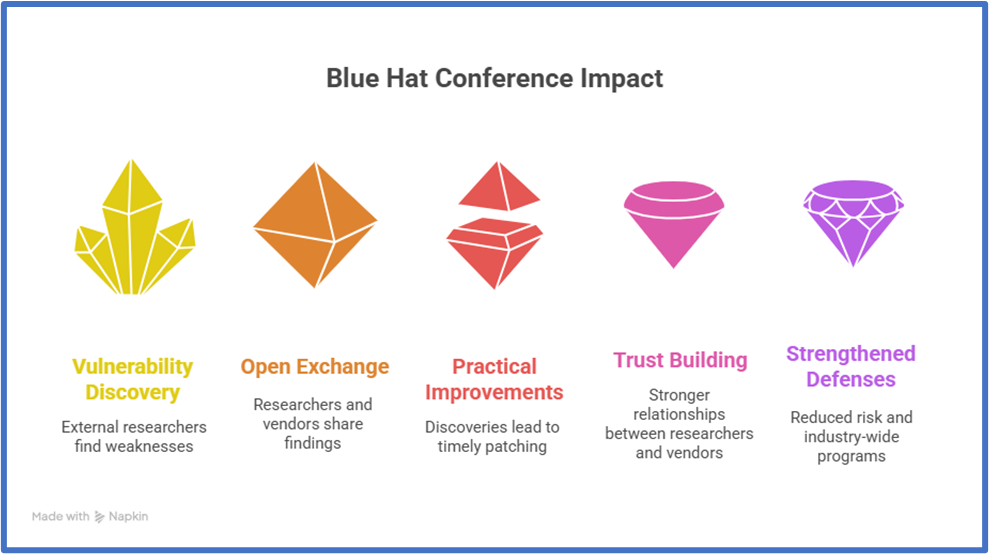Security holes can exist from the moment your system is deployed, even before it reaches users. According to Comparitech, 84% of companies face critical weaknesses on their network perimeters, which can be exploited by threat actors such as wifi hackers.
This brings the term “blue hat hackers” to the table. Here’s what you’ll find in this post: what blue hat hackers do, the skills that set them apart, how they compare with other hacker profiles, the role of the Blue Hat Microsoft Hacker Conference, and real-world examples that show their value.
Need support after a scam? Join our community today.
What Are Blue Hat Hackers?
Blue hat hackers are external cybersecurity specialists hired to spot and report weaknesses before a product, system, or service goes live. Their work happens in the pre-release stage of the software lifecycle, when fixes can still be applied without exposing them to users.
HackerOne data shows that 13%–20% of reports in public bug bounty programs are valid, while private programs have a success rate closer to 45%. This difference points to the benefits of targeted, pre-release audits led by blue hat hackers, where testing is more focused and results are easier to act on.
Example of a blue hat hacker in action
An e-commerce company plans a new payment gateway and brings in blue hat hackers before launch. During testing, they uncover a flaw that could let an attacker hijack transactions. The issue is patched ahead of release, avoiding financial loss.
Learn how to protect your social media accounts from hackers with 10 safety tips.
What Does A Blue Hat Hacker Do In Cybersecurity?
In cybersecurity, blue hat hackers step in for the final review before a system, app, or infrastructure goes live. Their role is to detect exploitable gaps that haven’t surfaced in real-world conditions.
They work in a controlled testing environment, applying techniques commonly used by attackers to evaluate system defenses. This method allows them to detect issues that internal teams may not have identified. Here are their core responsibilities:
1. Advanced Penetration Testing
Goes beyond standard scans by recreating real-world attack scenarios in a controlled lab. This approach reveals how far a hacker could move through a network, server, or application before triggering detection or being blocked. The process examines lateral movement, privilege escalation, and data exfiltration attempts to give a realistic picture of potential damage.
2. Zero-Day Exploit Evaluation
Focuses on identifying vulnerabilities that are unknown to the vendor and the public. These high-impact flaws are identified before the affected software reaches production use. This allows security teams to deploy patches early, reducing exposure time and minimizing the risk of exploitation.
3. Analysis of Emerging Attack Vectors
Evaluates the organization’s defenses against newer or less common threats. This can include spear-phishing campaigns, malicious code injections, compromised third-party integrations, and abuse of APIs. Teams simulate these tactics to evaluate how effectively their security measures handle advanced and new techniques.
4. Delivery of Detailed Technical Reports
Provides teams with a clear, actionable breakdown of findings. Each report includes technical evidence, the potential business impact, and step-by-step remediation guidance. This ensures security staff can prioritize fixes effectively and address vulnerabilities without unnecessary delays.
What Skills Do Blue Hat Hackers Have?
In cybersecurity, blue hat hackers deliver results when strong technical work meets clear communication. That mix keeps teams focused and reduces the chance of costly mistakes.
Technical Skills of Blue Hat Hackers
Blue hat hackers apply targeted techniques to uncover weaknesses before attackers can exploit them:
- Vulnerability scanning: combine automated scans with manual review across networks, servers, web apps, and operating systems to separate noise from real exposure.
- Reverse engineering: analyze binaries, libraries, and executables with debuggers and disassemblers to study inner behavior and locate weak spots.
- Malware analysis: uses sandboxes and isolated labs to watch installation steps, file changes, outbound calls, and any attempt to spread.
- Exploit development for testing: create proof-of-concept exploits to confirm the severity of vulnerabilities, and demonstrate how they could be abused if left unpatched.
- Secure code auditing: review source code line by line to pinpoint unsafe functions, logic flaws, and improper input handling that automated tools might overlook.
Soft Skills of Blue Hat Hackers
Technical skills are only useful if teams can act on them. That’s why blue hat hackers also focus on communication and collaboration:
- Explain findings in plain language: clarify what was discovered, why it matters, and what steps need to be taken.
- Set remediation priorities: guarantee critical issues are addressed first to maintain momentum during security updates.
- Document with accuracy: provide detailed evidence, clear scope, business impact, and step-by-step remediation guidance.
- Collaborate across teams: work smoothly with developers, operations, and management to ensure fixes are secure and practical.
- Adapt to changing conditions: adjust testing strategies if project requirements, threats, or system environments shift during engagement.
Have questions about dealing with scams? Contact us for support.

How Are Blue Hat Hackers Different from Other Hackers?
In cybersecurity, hackers run with different objectives and under different conditions. Each “hat” signals a function, a motivation, and a distinct risk profile. Knowing these differences makes it easier to see how each type contributes to security—or puts it at risk.
| Type of hacker | Main functions | Motivations | Risk level for an organization |
| Blue hat hackers | Pre-release testing in controlled environments to detect vulnerabilities before launch. | Strengthen security and head off attacks before release. | Low, since work is contracted and authorized. |
| White hat | Continuous audits, system monitoring, and incident response. | Keep internal security steady over time. | Low, when actions follow agreed terms. |
| Black hat | Malicious operations, data theft, malware deployment. | Financial gain, espionage, or sabotage. | Very high, due to illegal and destructive activity. |
| Grey hat | Find flaws without prior permission; may disclose or exploit them. | Recognition, curiosity, or personal advantage. | Medium to high, based on disclosure vs. sale. |
| Red hat | Counter hostile hackers using aggressive methods. | Protect systems by striking back at adversaries. | Medium, with possible collateral damage. |
| Green hat | Learners who are building skills and testing tools. | Grow cap | Unclear, risk depends on behavior and oversight |
What Is The Blue Hat Microsoft Hacker Conference?
The Blue Hat Microsoft Hacker Conference is a well-known cybersecurity event closely linked to blue hat hackers. It began as a Microsoft effort to bring in external researchers and work together on finding weaknesses before launch. Over time, that format evolved into a model many companies used to strengthen their defenses.
Impact on the Cybersecurity Ecosystem
At the conference, people share ideas freely, which helps turn discoveries into practical fixes and stops future attacks. Some contributions include:
- Reducing risk through timely patching.
- Building trust between researchers and vendors.
- Inspiring similar programs across the industry.
How It Connects to Blue Hat Practices
The name reflects how blue hat hackers operate: step in pre-release, surface gaps, and propose fast remediation. At the event, specialists:
- Present fresh testing methods.
- Share real-world case work and research paths.
- Partner with development teams to apply improvements quickly.

Blue Hat Hackers: The Audit Your Digital Security Needs
Blue hat hackers act as the final review before a product or system goes live. In a fast-moving threat space, this role helps organizations anticipate attacks and protect their digital reputation.
At Cryptoscam Defense Network, we follow the same approach to help you prevent fraud and targeted attempts—from crypto scams to celeb hacker campaigns taken at high-interest profiles.
Frequently Asked Questions (FAQ) About Blue Hat Hackers
When should you hire blue hat hackers?
Engage them just before a product or critical system goes live. Their external, targeted review helps detect gaps that internal teams may have missed.
How much does a Blue Hat hacker’s project cost?
Public pricing is rare, so teams often use penetration testing as a proxy. A standard test can range from US $4,000 to US $100,000, depending on scope and complexity.
Is this type of hacking legal?
Yes, when there is written authorization. Blue hat hackers work as contracted consultants who assess systems without crossing legal boundaries.
How is this different from a bug bounty program?
Bug bounty programs invite broad participation after release. Blue hat hackers perform focused, pre-launch testing as part of proactive audits.
We Want to Hear From You!
Fraud recovery is hard, but you don’t have to do it alone. Our community is here to help you share, learn, and protect yourself from future fraud.
Why Join Us?
- Community support: Share your experiences with people who understand.
- Useful resources: Learn from our tools and guides to prevent fraud.
- Safe space: A welcoming place to share your story and receive support.
Find the help you need. Join our Facebook group or contact us directly.
Be a part of the change. Your story matters.





